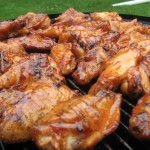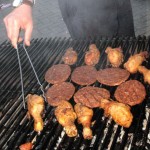If you take it by the typical Brit, we are every bit as keen on al fresco cooking and eating as any nation in the world, but in so doing have to overcome the blessings of weather that may turn your fire into a puddle without warning and a lamentable lack of skill and technique among our menfolk, who insist on being BBQ chefs. That is the cliche, but in fairness, everybody loves cooking a BBQ!
In fact, women often grumble, not without cause, that men love to claim the credit for all the hard work, yet it’s they who do the preparation and clearing up afterwards – he just warms the burgers. Well this cook is happy to do the lot, with or without assistance, for love of really good charcoal-grilled food, and not a single fatty burger in sight!
First things first, what sort of barbecue to choose? Well I admit I did briefly flirt with a gas BBQ, since it works regardless of the weather. I used it up to the point when a split in the rubber hose caused flame to shoot out horizontally, almost setting light to an unfortunate guest in the process. Luckily, plenty more people have had BBQ disasters, but there is a much simpler rule to be applied on your choice of fuels: charcoal and other natural burning substances produce an infinitely better flavour, and contrary to rumours are not really that much more difficult to use. Yes, it takes time but then the best things always do!
As for the actual shape and size of your barbie, much will depend on your budget, where you want to put it, how many people you want to cook for etc. The ideal solution is to have a brick-built barbie with a range of shelves inbuilt for your griddle and warming trays, but most people will buy their own DIY construction job, probably from the local B&Q or Homebase. These differ to varying degrees, but whichever style you choose do buy something substantial that won’t collapse about the patio the first time you touch it. Not really sure I trust anything on wheels, though inevitably they do have a degree of mobility. Mine is a half kettledrum type – nothing spectacular but does do the job.
Next question is about choice of charcoal and lighting it. It generally comes in two forms: briquettes or natural pieces of charcoal, though you can also buy ready-made easy-light bags to overcome the distasteful job of building up your own fire and getting hands dirty. I’m not generally keen on getting dirt up my fingernails, but there is something intensely rewarding about building your own fire.
Choose a spot sheltered from the wind (and rain!), then build a layer of charcoal. Put a couple of firelighters on top, then build more charcoal on top, but in such as way that there is free circulation of air to oxygenate your fire. I also tend to squirt firelighting solution on the charcoal (not petrol!), but don’t do so when the fire is lit! Light, then stand back, allow the fire to spread through all the charcoal. Gradually spread it out but keep a concentration on one side of the BBQ so you get hotter and cooler areas. Allow to burn down to a glow before you start cooking, or you may end up with food burnt to a crisp on the outside but raw in the middle, like the advert that drove many people up the wall!
Also remember to oil your griddle before you cook, but do so off the heat – dripping oil into your fire is not a good idea! However, one idea worth pursuing is the use of hickory or other hard wood chips. If you soak them in water for a few minutes before putting on the fire, they will smoke your food with a very sweet flavour. Branches of herbs such as thyme and rosemary can be used to equally good effect.
A good idea for starters is corn on the cob, which I buy in the husk and strip out the silk. The husks will burn but the corn will be very tender. You can do it in foil but some singed areas infused with charcoal smoke make for a very tasty dish. Also cook pitta breads on both sides, chop and serve with dips.
As for the food, it’s all in the preparation and right equipment. If you’re doing fish, invest in one of the devices for holding a fish over the BBQ, since you can then turn them easily without the risk of breaking up the delicate flesh, though you can also use such devices for cooking sausages and other foods simply and effectively. I also use a BBQ wok, a square device with holes to let in the charcoal smoke, but which allows you to cook veg and other smaller foods without losing them down the cracks and into the flame. Yes, kebabs do the same job though do remember to soak wooden skewers in water before you use them, to prevent burning.
As a recent Guardian article on the subject of BBQ marinades put it, “to break free of the infernal trinity (burgers, bangers and barbecue wings), you need to master the art of the marinade.” Almost every sort of meat, fish and veg are worth marinading prior to cooking, then basting during cooking. It keeps them moist and enhances the flavour. With meat and fish, the options are many and varied – make up your own marinades! There are a fair number suggested here and here, but it really is pretty simple. My basic standard BBQ marinade recipe, useful for ribs or chicken, contains some oil, worcester sauce, tomato ketchup, chilli sauce, garlic puree, salt, pepper and mustard powder, but I’d encourage you to experiment with fresh herbs and spices, lemon and other citrus zest and juices, oils and vinegars and many other flavourings.
For example, mushrooms have a tendency to dry up horribly on the BBQ unless you oil them, but then you can marinade them with chopped garlic, finely chopped parsley and a chilli. The flavour can be divine!
Anything on the bone or in larger pieces (eg. you can do roasting joints on the BBQ, providing you control the temperature and cook over a longer period) benefits from being pre-cooked, then finished off on the griddle. Steak is great rare in the middle, but chicken raw on the bone is not. Always check whether it is cooked through by plunging a skewer into the thickest part of your meat to test the colour of the juices – clear is good. If you want to be more sophisticated, a meat thermometer will to the best job of all.
Keep a flow of cooked food by using the grill in sequence to cook the stuff that takes longest and some quicker foods to keep it coming for your hungry guests. You can always move food around so the stuff already cooked is left to keep warm while the other foods are getting the eye of the heat. Most meats, steaks and prime cuts apart, benefit from gentler cooking, during which they take up more of the flavour of the charcoal and any woods you have used.
Make your salads in advance (home-made potato salad – see my recipe included on this page – and coleslaw are worth doing), but don’t make the mistake of dressing green salad until the last moment. And don’t forget the Pimms either (though I use 1:1, not the horribly dilute 1:3 recommended in that recipe!!)
Shame to waste your BBQ while it’s still hot, so try a cooked dessert too. The one I liked was to take bananas, slit them, pour in alcohol and demerera sugar, coat in foil then cook on the barbecue for 10 minutes. You can apparently do similar things with pineapples, too.
Above all, if you’re the chef don’t forget to have some food and drink yourself, chat with your guests and enjoy it. Relaxation is the way to go – and the point of al fresco dining. But if you’re like me, my final tip for patio cooking is to remember to wear a cap – nothing worse than burning the top of your head while you’re attending to the fires below!!
PS. My recipes for BBQ sticky ribs and beer can BBQ chicken are definitely worth a bash! 😛





